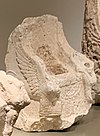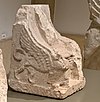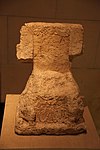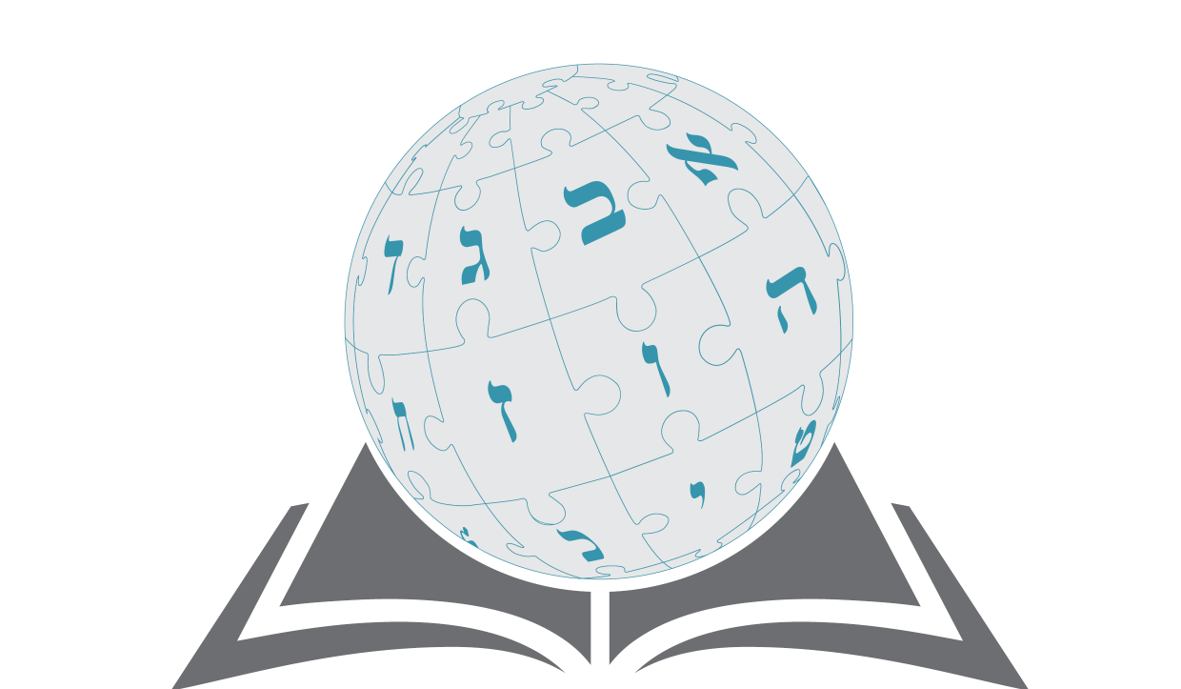כס עשתרת
מראה
(הופנה מהדף כס כרובים)
כסי עשתרת הם כסאות כרובים שהוקדשו כמִנְחָה, ונמצאו במקדשים פיניקים עתיקים, במיוחד באזורים סביב צידון, צור ואום אל-עמד (אנ').[1] לרבים מהכסים יש סגנון דומה, עם ראשי כרובים על גופי אריות מכונפים משני צדי הכס.[2] ייצוגים של הכס נמצאו באתרים פיניקים סביב הים התיכון, כולל לוח שנהב מתל מגידו, ארון אחירם מגבל, תבליט מהדרומטום (אנ') בקרבת קרתחדשת ועל חותם מת'רוס (אנ') בסרדיניה.[2]
רשימת כסים מפיניקיה
| תמונה | תקופה | אתר | מיקום נוכחי | כתובת | תיאור | פרסום ראשון |
|---|---|---|---|---|---|---|

|
הלניסטי | גבל | המוזיאון הלאומי של ביירות | אין | בחזית, שתי דמויות נוסכות נסך לתור פרח. על המושב, משטח מלבני להצבת חפץ.[3] | מוריס דוננד (אנ')[4] |

|
הלניסטי | צידון | המוזיאון הלאומי של ביירות | אין | בחזית, עיטור פיניקי (אנ'). על המושב, מגרעת גדולה מלבנית לייצוב חפץ. משענת ללא קישוטים.[3] | דוננד 1941[5] |

|
רומאי | צידון | המוזיאון הלאומי של ביירות | כתובת יוונית | מושב מאוד משופע, ללא אפשרות להצבת חפץ. על המשענת, סמל סהר וכוכב (המזוהה עם בעל חמון[6]).[3] | 1924[7] |

|
צידון | מוזיאון הלובר | אין | נאיסקוס (אנ') ובתוכו כס עם שני ספינקסים. מעל הכס, חלל בצורת U להצבת חפץ עגול בתחתיתו: או בית אל וכתרו. בצדדים, כהנים בעבודתם.[3] | 1933[8] | |

|
צידון | המוזיאון לארכאולוגיה של איסטנבול | אין | נאיסקוס (אנ') דומה לקודם. מאחור, חלל קטן להצבת חפץ. בצדדים, אלה מכונפת.[3] | [9] | |
| המאה ה-2 לפנה"ס | מדרום לצור | מוזיאון הלובר | כתובת הקדשה פיניקית לעשתרת, ידועה כ-KAI 17 |
על הכס, שתי מצבות עם תבליטים המתארים כוהנים.[3] | 1907 Ronzevalle[10][11][12] | |

|
הלניסטי | עין בעאל (ליד צור) | המוזיאון הלאומי של ביירות | אין | מושב הכולל מצבה או בית אל.[3] | |

|
הלניסטי | אזור צור | המוזיאון הלאומי של ביירות | אין | מושב הכולל מצבה או בית אל.[3] | |

|
המאה ה-4 לפנה"ס | אום אל-עמד | מוזיאון הלובר | אין | בחזית, עיטור פיניקי (אנ').[3] | ארנסט רנן 1860[13] |

|
אום אל-עמד | המוזיאון הלאומי של ביירות | אין | החזית שבורה. מושב אופקי, עגול בחזיתו. משענת ללא קישוטים. הכס גדול ויכול להתאים לאדם.[3] | דוננד | |

|
מקדש אשמון (ליד צידון) | מקדש אשמון | אין | דוננד | ||

|
מקדש אשמון (ליד צידון) | המוזיאון הלאומי של ביירות | אין | דוננד | ||

|
הלניסטי | לא ידוע | המוזיאון הלאומי של ביירות | אין |
ייצוגים נוספים
צלמיות
ייצוגים דו־מימדיים
-
כס מלכות דומה מתואר על ארון אחירם[14]
ראו גם
לקריאה נוספת
- Sébastien Ronzevalle, Le "Trône d’Astarté", Mélanges de la Faculté Orientale (Beirut) 3 (1909), 755–83, pls 9–10;
- Ernest Will, Du Môtab de Dusarès au trône d'Astarté, Syria. Archéologie, Art et histoire 63, 1986, עמ' 343–351 doi: 10.3406/syria.1986.6940
- Sébastien Ronzevalle, Note sur un monument phénicien de la région de Tyr, Comptes-rendus des séances de l année - Académie des inscriptions et belles-lettres 51, 1907, עמ' 589–598 doi: 10.3406/crai.1907.71970
- James R. Davila, Bruce Zuckerman, The Throne of ʿAshtart Inscription, Bulletin of the American Schools of Oriental Research 289, 1993-02, עמ' 67–80 doi: 10.2307/1357365
- Józef T. Milik, Les papyrus araméens d'Hermoupolis et les cultes syro-phéniciens en Égypte perse, Biblica 48, 1967, עמ' 546–622
- Henri Seyrig, Antiquités syriennes, Syria. Archéologie, Art et histoire 36, 1959, עמ' 38–89 doi: 10.3406/syria.1959.5447
- Edward Lipiński, Rereading the Inscriptions of the ‘Throne of Astarte’ and the Sidonian Obelisk, Journal of Semitic Studies 61, 2016-10, עמ' 319–325 doi: 10.1093/jss/fgw011
קישורים חיצוניים
הערות שוליים
- ↑ Milik, 1967
- ^ 2.0 2.1 Davila and Zuckerman (1993), p.77: "Compare the votive throne discovered at Umm el-'Amed (Dunand and Duru 1962: 168 pl. 67). The lower part of the throne is badly damaged, but the heads are preserved. The heads are human, and each bears a head-dress or coiffure that reaches down to the shoulders. They also have stylized beards. On our throne, what remains of the headdresses/coiffures and beards of the cherubs stylistically parallels those of the Umm el-'Amed cherubs. In fact, it seems quite probable that they stem from the same artistic and iconographic milieu. We may further note the cherub thrones depicted on a Late Bronze/ Iron I ivory from Megiddo, the sarcophagus of Ahiram (cf. Pritchard 1969: figs. 332, 456-59, respectively), a relief from Hadrumetum/Sousse (Cintas 1947: pls. 48-49), and a scarab from Sardinia (Bisi 1967: fig. 57). In each of those exemplars the cherubs have a feline body with wings, a tail, and styled hair, but no beard."
- ^ 3.00 3.01 3.02 3.03 3.04 3.05 3.06 3.07 3.08 3.09 Henri Seyrig's original list of 10 known thrones in 1959: Seyrig, 1959, page 51-52
- ↑ M. Dunand, Excavations of Byblos, II, p. 79, no.7225, p. 152
- ↑ Dunand, Bulletin du Musée de Beyrouth, V, 1941, p. 93, where the origin is given as unknown.
- ↑ יגאל ידין, על סמלי האלילים בשמאל (זינג'ירלי), בקארתאגו ובחצור, ידיעות בחקירת ארץ-ישראל ועתיקותיה ל"א 4, תשכ"ז / 1967, עמ' 29-63
- ↑ Charles Virolleaud, Les travaux archéologiques en Syrie en 1922-1923, Syria. Archéologie, Art et histoire 5, 1924, עמ' 119, pi 32 doi: 10.3406/syria.1924.3036, where the origin is given as unknown. The throne had been received in Sidon by L. Brossé: cf. Noel Aimé-Giron, Bulletin de l'Institut Français d'Archéologie Orientale, XXV, 1925, p. 206
- ↑ Noel Aimé-Giron, Bulletin de l'Institut Français d'Archéologie Orientale, XXXIV, 1933, pp. 31-; René Dussaud, Noel Aimé-Giron. — Un naos phénicien de Sidon (avec 4 planches). Extrait du Bulletin de l'Institut français d'archéologie orientale., Syria. Archéologie, Art et histoire 14, 1933, עמ' 335–336
- ↑ G. Mendel, Catal. of sculpt. (Museums imper. Ottom.), I, n ° 92 (attribution in the 5th century); Noel Aimé-Giron, Bulletin de l'Institut Français d'Archéologie Orientale, XXV, 1924, pp. 191-; cf. A. Dessus-Lamare-Leenhoff, Ernest IIerzfeld. — Die Ausgrabungen von Samarra, Band I. — Der Wandschmuck der Bouten von Samarra und seine Ornamentik, avec 321 gravures et 101 planches. (Forschungenzur islamischen Kunst herausgegeben von Friedrich Sarre)., Syria. Archéologie, Art et histoire 6, 1925, עמ' 93–97
- ↑ Sébastien Ronzevalle, Note sur un monument phénicien de la région de Tyr; In: Comptes rendus des séances de l'Académie des Inscriptions et Belles-Lettres, 51ᵉ année, N. 10, 1907. pp. 589-598; DOI : https://doi.org/10.3406/crai.1907.71970
- ↑ Ronzevalle, 1909, p.755-
- ↑ Clermont-Ganneau, in Repert. epigr. sémit., n ° 800.
- ↑ E. Renan, Mission de Phénicie (1865–1874), p.707 and plate LIII: "Le petit fauteuil représenté planche LIII est une restitution en partie hypothétique de l’ensemble formé par deux fragments que nous avons rapportés (au Louvre, Catal. n° 75 et 76). Le globe ailé, les bras en forme d’aile, les sculptures fines, quoique très-frustes, du devant sont certains. Les figures des angles sont très-difficiles à agencer." (באנגלית: "The small armchair shown on Plate LIII is a partly hypothetical restitution of the whole formed by two fragments that we have brought back (to the Louvre, Catal. N ° 75 and 76). The winged globe, the wing-shaped arms, the fine, though very rough, carvings on the front are certain. The angle figures are very difficult to arrange.")
- ↑ Noël Aimé-Giron, Un ex-voto à Astarté, BIFAO 25 (1925), p. 191-211
- ↑ לוחית שיבוץ הנושאת תיאור עלילתי, שגיבורו הוא שליט כנעני, באתר מוזיאון ישראל, 2022-01-25
| אלילים במיתולוגיה הכנענית | ||
|---|---|---|
| הפנתאון הכנעני | אדון • אל • אשרה • בעל • בעל זבוב • בעל פעור • גד • גפן-ואֻגר • דגון • חורון • ים • ירח • כושר וחסיס • כושרות • כמוש • מולך • מות • נכל ואיב • סער • ענת • עשתר • עשתרת • קדש-ואמרר • רשף • שחר • שלם • שפש • תרפים |

|
| אתרים מיתולוגיים | אוגרית • פסגת הצפון | |
| כתבים דתיים | אגדת אקהת • אגדת כרת • עלילות בעל וענת • שירה אוגריתית | |
| פולחן | במות • מצבה • מקדש מגדול • נסך וקטורת • סעודת מרזח | |
| הנהגה דתית | בעלת האוב • כהנים (כמרים) • קדשים (קדש וקדשת) | |
כס עשתרת34570419Q97787216




![כס מלכות דומה מתואר על ארון אחירם[14]](https://upload.wikimedia.org/wikipedia/commons/thumb/2/28/Ahiram.jpg/90px-Ahiram.jpg)

